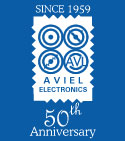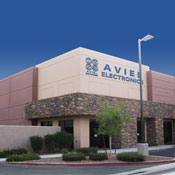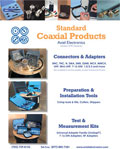WiFi Interface Identifier
Download PDF
Today's wireless market has exposed us to many new, and some familiar connectors. The wide range of antennas, access points, routers, WLAN's, cellular devices, PCMCIA cards, Bluetooth, and wireless broadband equipment now available to meet Wi-Fi IEEE802.11a/b/g requirements can sometimes seem bewildering. What are the input and output connectors used with Wi-Fi® certified products which include: access points, gateways, residential gateways, PC cards, PCI cards, PCMCIA cards, UB devices, wireless print servers, WLAN enabled computers, PC peripherals, antennas, LANs and Internet access devices? Many of these connectors are not easily recognizable. We will try to give you a little background on the common Wi-Fi connectors and some tips to help you identify them.
In addition to specialized interfaces which are relatively new to the coaxial market, such as DMX, MC Card, MHF, there are variations on standard RF connectors styles which satisfy FCC Part 15 and 802.11 requirements. The most popular method used to achieve compliance has been to create reverse polarity, or gender, versions of BNC, MCX, MMCX, N, SMA, SMB, SSMB and TNC connectors. You will also find reverse, or left-handed thread versions of N, SMA and TNC connectors.
QMA
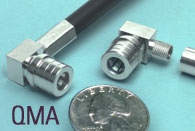 QMA connectors are quick disconnecting versions of SMA connectors; they snap on and off rather than mate by turning threads. QMA's couple in two seconds rather than twenty, but more importantly, they can be rotated 360 degrees after they are mated, optimizing the flexibility of installations and durability of jumpers. The QMA coupling mechanism creates a 360-degree butt joint that is maintained even with rotation, resulting in low RF leakage. Because QMA's are internally identical to SMA's, they offer low loss RF performance from DC to 6 GHz, but can be used up to 18 GHz. They offer the high power handling capability of the SMA with the ability to be used in a denser environment. This is one of the reasons we are seeing increased usage of this 50-ohm interface in the Wi-Fi device arena.
QMA connectors are quick disconnecting versions of SMA connectors; they snap on and off rather than mate by turning threads. QMA's couple in two seconds rather than twenty, but more importantly, they can be rotated 360 degrees after they are mated, optimizing the flexibility of installations and durability of jumpers. The QMA coupling mechanism creates a 360-degree butt joint that is maintained even with rotation, resulting in low RF leakage. Because QMA's are internally identical to SMA's, they offer low loss RF performance from DC to 6 GHz, but can be used up to 18 GHz. They offer the high power handling capability of the SMA with the ability to be used in a denser environment. This is one of the reasons we are seeing increased usage of this 50-ohm interface in the Wi-Fi device arena.
FME
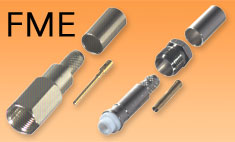 FME, or "Euro-Nipple", connectors originated in Europe and are used most prominently in antenna couplings. They have 50 ohm impedance and operate in the frequency range of DC to 200 MHz. They mate with M8XP .75 threads and the female has the distinctive "nipple" appearance.
FME, or "Euro-Nipple", connectors originated in Europe and are used most prominently in antenna couplings. They have 50 ohm impedance and operate in the frequency range of DC to 200 MHz. They mate with M8XP .75 threads and the female has the distinctive "nipple" appearance.
F
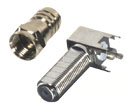 You will find "F" series connectors primarily in antenna & television cable applications. It is the F connector that is most recognized by the general public when you speak of coaxial connectors to them. Standard F connectors have nominal 75 ohm impedance, working voltage rating of 500 VRMS, operate in the frequency range of DC to 1 GHz, and 3/8-32 coupling threads. Push-on versions available, but do not make secure connections. New wireless applications sometimes require "precision" F connectors, which perform at higher frequencies & with truer impedance.
You will find "F" series connectors primarily in antenna & television cable applications. It is the F connector that is most recognized by the general public when you speak of coaxial connectors to them. Standard F connectors have nominal 75 ohm impedance, working voltage rating of 500 VRMS, operate in the frequency range of DC to 1 GHz, and 3/8-32 coupling threads. Push-on versions available, but do not make secure connections. New wireless applications sometimes require "precision" F connectors, which perform at higher frequencies & with truer impedance.
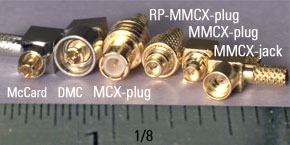
MMCX
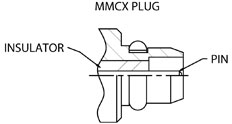 The MMCX, "miniature MCX", micro-miniature series of 50Ω connectors was developed in the 1990's for use with densely packed PCB layouts. They are about half the size of the SMB. Their lock-snap coupling mechanism with non-slotted outer contact allows 360 degree rotation without loss of broadband performance and with low reflection from DC to 6 GHz. MMCX connectors conform to European CECC 22000 specifications and their snap-on coupling reduces installation time. MMCX plugs have no shell, a center pin and visible external snap-ring. MMCX jacks have a larger body, center socket contact and internal spring slots to receive the external snap-ring of the plug. One way to differentiate MCX and MMCX plugs if you do not have one of each for comparison is to remember that the MCX has slotted external spring fingers while the MMCX has a solid external contact with snap-ring.
The MMCX, "miniature MCX", micro-miniature series of 50Ω connectors was developed in the 1990's for use with densely packed PCB layouts. They are about half the size of the SMB. Their lock-snap coupling mechanism with non-slotted outer contact allows 360 degree rotation without loss of broadband performance and with low reflection from DC to 6 GHz. MMCX connectors conform to European CECC 22000 specifications and their snap-on coupling reduces installation time. MMCX plugs have no shell, a center pin and visible external snap-ring. MMCX jacks have a larger body, center socket contact and internal spring slots to receive the external snap-ring of the plug. One way to differentiate MCX and MMCX plugs if you do not have one of each for comparison is to remember that the MCX has slotted external spring fingers while the MMCX has a solid external contact with snap-ring.
Reverse MMCX
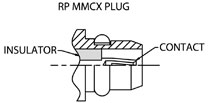 Reverse MMCX plugs have the dielectric and center socket of the MMCX jack inside the MMCX body. To identify them, look closely into the center of the connector. If you find a socket contact in a body with external snap-ring, you have an RP MMCX plug. They will not mate with standard MMCX jacks. To attempt to do so will damage contacts in both connectors. All performance and function characteristics of the MMCX connector apply to the RP MMCX.
Reverse MMCX plugs have the dielectric and center socket of the MMCX jack inside the MMCX body. To identify them, look closely into the center of the connector. If you find a socket contact in a body with external snap-ring, you have an RP MMCX plug. They will not mate with standard MMCX jacks. To attempt to do so will damage contacts in both connectors. All performance and function characteristics of the MMCX connector apply to the RP MMCX.
MCX
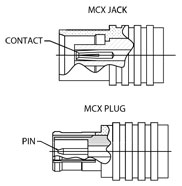 MCX, sometimes called OSX, connectors were first used in the 1980's and conform to CECC 22220 specifications. They share the same inner contact and dielectric dimensions as the SMB connector, but the outer diameter of the MCX plug is approximately 30% smaller than the SMB. Fifty-ohm MCX connectors require less engagement/disengagement force than SMB's and offer broadband performance from DC to 6 GHz with a voltage rating of 335 VRMS [depending on cable used], 250 V max working voltage and withstanding voltage of 1,000 volts. Coupled MCX connectors can be rotated 360 degrees for precision alignment without performance loss. MCX plugs have a center pin, dielectric, or insulation, which extends beyond the pin, and six slotted spring fingers surrounding the insulation. The MCX plug inserts into the jack body. MCX jacks have a larger diameter body housing the locking mechanism for the plug's springs, recessed insulation and a slotted socket contact.
MCX, sometimes called OSX, connectors were first used in the 1980's and conform to CECC 22220 specifications. They share the same inner contact and dielectric dimensions as the SMB connector, but the outer diameter of the MCX plug is approximately 30% smaller than the SMB. Fifty-ohm MCX connectors require less engagement/disengagement force than SMB's and offer broadband performance from DC to 6 GHz with a voltage rating of 335 VRMS [depending on cable used], 250 V max working voltage and withstanding voltage of 1,000 volts. Coupled MCX connectors can be rotated 360 degrees for precision alignment without performance loss. MCX plugs have a center pin, dielectric, or insulation, which extends beyond the pin, and six slotted spring fingers surrounding the insulation. The MCX plug inserts into the jack body. MCX jacks have a larger diameter body housing the locking mechanism for the plug's springs, recessed insulation and a slotted socket contact.
Reverse MCX
Reverse MCX connectors have pins and sockets reversed. All other features and characteristics of the standard MCX remain the same.
N
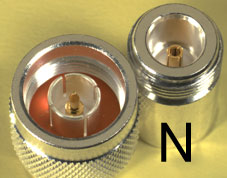 Type N connectors were designed by Paul Neill an RF engineer at Bell Labs, in the 1940's for military systems and were the first coaxial connectors with true microwave performance. N connectors use an internal gasket as a weatherproofing seal and have an air gap between inner and outer contacts. When you look into an N male, you will see this gasket inside the rotating, 5/8-24 threaded coupling shell at the base of the slotted outer ground ring and a pin as center conductor. The N female has a slotted socket contact and a tapered inner contour to engage the ground ring of the male connector. Fifty-ohm N connectors conform to military standard MIL-C-39012 and perform at frequencies up to 12 GHz. Some versions have solid ground rings and can perform up to 18 GHz, but you will typically find the slotted style in use. N connectors are widely used in broadband, cellular and other microwave applications. They are a common commercial antenna connector, so you will often need to jumper from N to other, smaller connectors.
Type N connectors were designed by Paul Neill an RF engineer at Bell Labs, in the 1940's for military systems and were the first coaxial connectors with true microwave performance. N connectors use an internal gasket as a weatherproofing seal and have an air gap between inner and outer contacts. When you look into an N male, you will see this gasket inside the rotating, 5/8-24 threaded coupling shell at the base of the slotted outer ground ring and a pin as center conductor. The N female has a slotted socket contact and a tapered inner contour to engage the ground ring of the male connector. Fifty-ohm N connectors conform to military standard MIL-C-39012 and perform at frequencies up to 12 GHz. Some versions have solid ground rings and can perform up to 18 GHz, but you will typically find the slotted style in use. N connectors are widely used in broadband, cellular and other microwave applications. They are a common commercial antenna connector, so you will often need to jumper from N to other, smaller connectors.
Reverse N
Reverse polarity N connectors have the slotted socket contact and ground ring in the male body and the pin in the female body. Only the contacts are reversed.
SMA
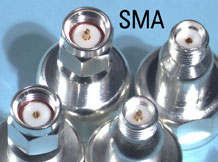 SMA, SubMiniature version A connectors (sometimes called OSM) were designed by Bendix Scintilla Corporation in the 1960's as 50 Ω, semi-precision units with small size, 1/4"-36 threaded coupling and high mechanical durability. They conform with MIL-C-39012 and CECC 22110/111 and are one of the most commonly used RF/microwave connector types used for frequencies from DC to 18 GHz. When used with miniature flexible cables their range is up to 12.4 GHz.
SMA, SubMiniature version A connectors (sometimes called OSM) were designed by Bendix Scintilla Corporation in the 1960's as 50 Ω, semi-precision units with small size, 1/4"-36 threaded coupling and high mechanical durability. They conform with MIL-C-39012 and CECC 22110/111 and are one of the most commonly used RF/microwave connector types used for frequencies from DC to 18 GHz. When used with miniature flexible cables their range is up to 12.4 GHz.
SMA males have hex shells with an internal gasket and a pin extending beyond the dielectric. The SMA female has external threads and slotted socket flush to the top of the dielectric.
Reverse SMA
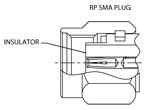 Reverse polarity SMA connectors share the same performance characteristics of standard SMA's, but the pin and socket are reversed. If you are looking into the shell of the male connector and see a flush socket and dielectric rather than raised pin, you have a reverse polarity SMA male. A raised pin in an SMA female connector indicates reverse polarity SMA female.
Reverse polarity SMA connectors share the same performance characteristics of standard SMA's, but the pin and socket are reversed. If you are looking into the shell of the male connector and see a flush socket and dielectric rather than raised pin, you have a reverse polarity SMA male. A raised pin in an SMA female connector indicates reverse polarity SMA female.
Reverse Thread SMA
Another method used to meet FCC Part 15 and 802.11b standards is to reverse the thread on connectors with threaded coupling. These are referred to as reverse, or left-handed thread connectors. They are otherwise identical to standard SMA connectors, but will not mate. To attempt to do so could damage both connectors.
MHF
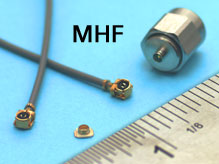 The MHF micro-coax connector is equivalent to the Hirose U.FL and Ipex series connectors found in many WiFi products. They are a low profile [2.5mm mating height] and support dual band 3-6 GHz applications.
The MHF micro-coax connector is equivalent to the Hirose U.FL and Ipex series connectors found in many WiFi products. They are a low profile [2.5mm mating height] and support dual band 3-6 GHz applications. 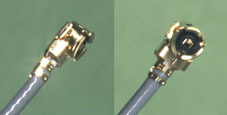
TNC
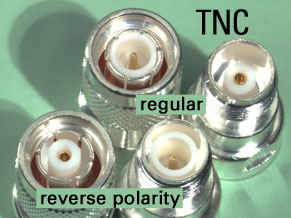 The TNC, Threaded Neill Concelman, was designed as a 7/16-28 threaded version of the 50 ohm BNC connector in the late 1950's to ensure that the connectors not de-couple during intense vibration. TNC's are weatherproofed with an internal gasket and operate from DC to 11 GHz. Internally they are identical to BNC connectors and meet MIL-39012 and MIL-STD-348. The standard TNC male has a rotating shell with gasket, slotted ground ring with dielectric material extending to its edge and a large air gap between this dielectric ring and the center pin. The TNC female has external threads and a slotted socket contact surrounded by a cylinder of dielectric material. When mated, the central dielectric of the female connector fits into the cavity of the dielectric ring in the TNC male and the tapered inner wall of the TNC female make contact with the spring fingers of the slotted ground ring of the TNC male.
The TNC, Threaded Neill Concelman, was designed as a 7/16-28 threaded version of the 50 ohm BNC connector in the late 1950's to ensure that the connectors not de-couple during intense vibration. TNC's are weatherproofed with an internal gasket and operate from DC to 11 GHz. Internally they are identical to BNC connectors and meet MIL-39012 and MIL-STD-348. The standard TNC male has a rotating shell with gasket, slotted ground ring with dielectric material extending to its edge and a large air gap between this dielectric ring and the center pin. The TNC female has external threads and a slotted socket contact surrounded by a cylinder of dielectric material. When mated, the central dielectric of the female connector fits into the cavity of the dielectric ring in the TNC male and the tapered inner wall of the TNC female make contact with the spring fingers of the slotted ground ring of the TNC male.
Reverse TNC
The reverse polarity version of the TNC connector swaps the dielectric and contact configuration of the male with the female. The ground ring and body of the male is not affected. All other performance characteristics remain the same.
Reverse Thread TNC
Threads are reversed, or left-handed, in this version of TNC connector. There is no other variation from the standard connector.
DMX
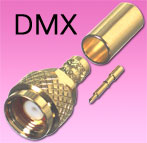 This standard polarity connector is similar in size to an SMA with modified M8XP .75 metric threads. Built for Wave Rider & and 802.11a/b bandwidth applications.
This standard polarity connector is similar in size to an SMA with modified M8XP .75 metric threads. Built for Wave Rider & and 802.11a/b bandwidth applications.
MC CARD
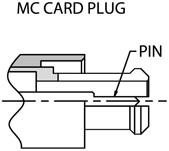 MC CARD CONNECTORS are designed for wireless and telecom devices operating at frequencies up to 8 GHz where board and chassis space is limited.
MC CARD CONNECTORS are designed for wireless and telecom devices operating at frequencies up to 8 GHz where board and chassis space is limited.


